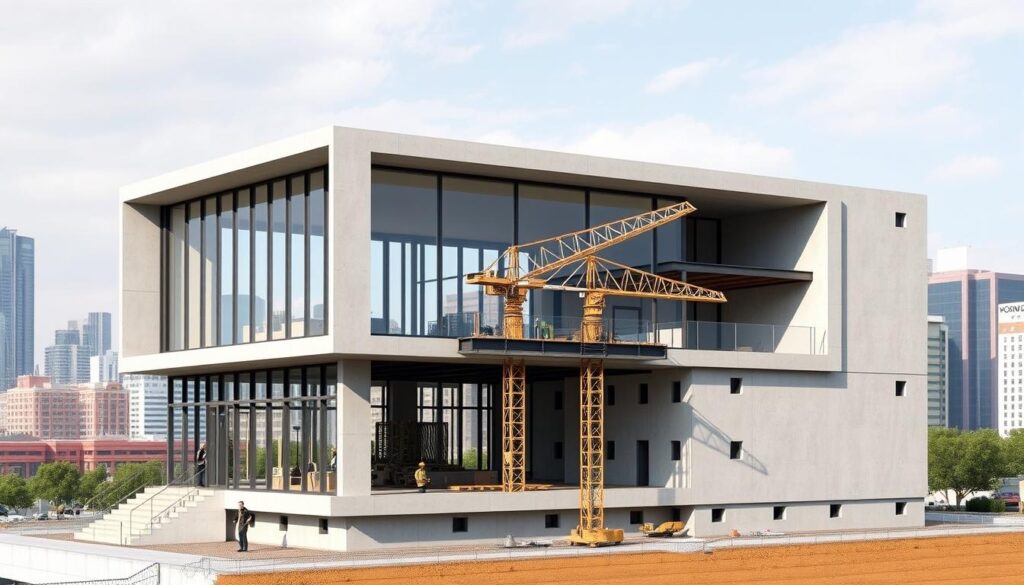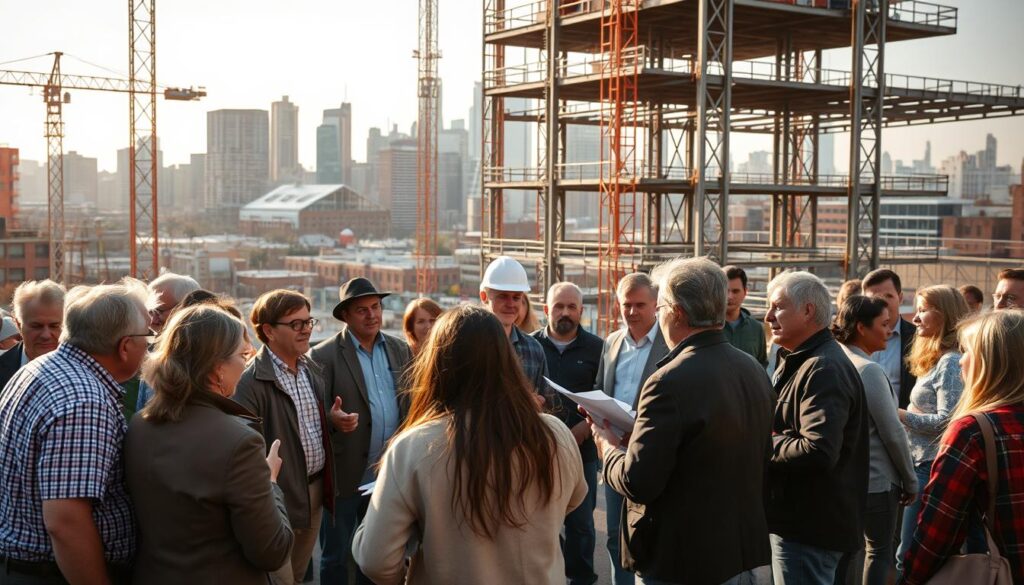The construction industry is on the cusp of a revolution, driven by technological innovations, sustainability concerns, and shifting workforce dynamics. A recent report highlights that the global construction market is expected to grow by 4.2% annually, driven by infrastructure development and urbanization. As the industry evolves, it’s crucial to stay informed about the latest trends shaping modern construction techniques and safety protocols.
The adoption of digital transformation and automation is transforming the construction landscape. From sustainable building practices to innovative materials and technologies, the industry is witnessing a significant shift. For more insights on the latest construction safety management trends, visit Struxhub’s blog.
Key Takeaways
- Technological advancements are driving the construction industry’s transformation.
- Sustainability efforts are becoming increasingly important in construction practices.
- Shifting workforce demographics are influencing construction techniques and safety protocols.
- Digital transformation and automation are key trends in modern construction.
- Innovative materials and technologies are enhancing construction safety and efficiency.
Introduction to Modern Construction Paradigms
Modern construction paradigms are transforming the industry, enhancing efficiency, productivity, and safety. The construction sector is rapidly evolving, driven by the adoption of new technologies and innovative methodologies. This transformation is not just about using new tools, but also about adopting sustainable practices that reduce environmental impact.
- Innovative construction methods that improve project outcomes.
- Sustainable building practices that reduce environmental footprint.
- Technological advancements such as digital twins and construction management software.
For instance, the use of innovative construction techniques can significantly reduce costs and enhance project efficiency. As the industry continues to evolve, it’s crucial to stay informed about the latest trends and technologies.
The benefits of modern construction paradigms are multifaceted, including improved safety records, reduced construction timelines, and enhanced building quality. By embracing these new paradigms, the construction industry can achieve significant advancements in the coming years.
The Rise of Sustainable Building Practices

The trend towards sustainable building practices is transforming the construction industry. Driven by environmental concerns and regulatory requirements, the shift towards eco-friendly methods is becoming increasingly important.
Sustainable building practices encompass a range of strategies aimed at reducing the environmental impact of construction projects. Two key areas of focus are the use of eco-friendly materials and innovations in energy efficiency.
Importance of Eco-Friendly Materials
Eco-friendly materials play a crucial role in sustainable building practices. These materials are sourced and manufactured in ways that minimize environmental harm. Examples include:
- Recycled materials, such as reclaimed wood and recycled metal
- Sustainably sourced timber, certified by organizations like the Forest Stewardship Council (FSC)
- Low-VOC (Volatile Organic Compound) paints and coatings
For more information on green building trends, visit Old Republic Title’s blog on green building.
Energy Efficiency Innovations
Energy efficiency is another critical aspect of sustainable building practices. Innovations in this area include:
- Advanced insulation materials that reduce heat loss and gain
- High-performance windows that minimize energy transfer
- Smart building technologies that optimize energy consumption
These innovations not only reduce the environmental impact of buildings but also offer significant cost savings over time. As the construction industry continues to evolve, the adoption of sustainable building practices is expected to become even more widespread.
Integrating Technology into Construction
The construction industry is on the cusp of a technological revolution, with innovations like digital twins and drones transforming project management. This technological integration is not just a trend but a necessity for improving efficiency, productivity, and safety on construction sites.
Digital Twins and Construction Management Software
One of the most significant advancements in construction technology is the development of digital twins, virtual replicas of physical construction projects. These digital models allow for real-time monitoring and simulation, enabling project managers to predict potential issues and make informed decisions. The integration of AI in civil is further enhancing the capabilities of digital twins.
Construction management software is another crucial tool that is streamlining project management processes. By centralizing data and automating tasks, these software solutions reduce the likelihood of human error and increase overall project efficiency.
| Technology | Benefits | Applications |
|---|---|---|
| Digital Twins | Real-time monitoring, predictive analysis | Project management, issue prediction |
| Construction Management Software | Centralized data, automated tasks | Project planning, execution, and monitoring |
| Drones | Site assessment, monitoring, and inspection | Surveying, progress tracking, safety inspections |
Drones in Site Assessment and Monitoring
Drones are increasingly being used in the construction industry for site assessment and monitoring. Equipped with high-resolution cameras and sensors, drones can capture detailed images and data, providing valuable insights into project progress and site conditions.
The use of drones not only enhances the accuracy of site assessments but also improves safety by reducing the need for manual inspections in hazardous areas. As the technology continues to evolve, we can expect to see even more innovative applications of drones in construction.
Smart Building Design Trends

Smart building design is transforming the construction landscape, leveraging technologies like IoT and BIM to create more sustainable and efficient buildings. This transformation is driven by the need for energy efficiency, sustainability, and occupant comfort.
The Role of IoT in Construction
The Internet of Things (IoT) is playing a pivotal role in modern construction by enabling real-time monitoring and management of building systems. IoT devices can track everything from energy usage to security, optimizing building performance and reducing operational costs. For instance, IoT sensors can detect leaks or structural issues early, preventing costly repairs and enhancing safety. As highlighted in a recent blog post on smart building technology, IoT is revolutionizing the way buildings are designed, constructed, and operated.
Benefits of Building Information Modeling (BIM)
Building Information Modeling (BIM) is another critical technology in smart building design. BIM involves creating detailed digital models of buildings, which can be used to simulate various scenarios, predict potential issues, and optimize the construction process. The benefits of BIM include improved collaboration among stakeholders, reduced errors, and enhanced project visualization. By adopting BIM, construction projects can achieve greater efficiency and accuracy, ultimately leading to better outcomes.
Smart Materials and Their Uses
Smart materials are also gaining traction in the construction industry due to their unique properties and potential applications. These materials can respond to environmental changes, such as temperature or light, and can be used to create adaptive building envelopes. Examples include self-healing concrete, thermochromic materials, and photovoltaic glass. The use of smart materials can enhance building performance, reduce maintenance needs, and improve occupant comfort.
In conclusion, smart building design trends are reshaping the construction industry by integrating advanced technologies like IoT, BIM, and smart materials. These innovations are not only improving building efficiency and sustainability but also enhancing occupant comfort and safety. As the industry continues to evolve, we can expect to see even more innovative applications of these technologies.
Safety Protocol Innovations
Innovations in safety protocols are transforming the construction industry, driven by technology and changing workforce demographics. The need for enhanced safety measures has never been more critical, with the industry witnessing a significant shift towards integrating advanced technologies into daily operations.
Advancements in PPE Technology
One of the key areas of innovation in safety protocols is the advancement in Personal Protective Equipment (PPE) technology. Modern PPE is not just about protecting workers from immediate hazards but also about enhancing their overall safety and comfort. For instance, smart helmets equipped with sensors can detect falls or impacts and alert supervisors. Wearable technology is becoming increasingly prevalent, providing real-time monitoring of workers’ vital signs and environmental conditions.
Furthermore, advancements in materials science have led to the development of more durable and comfortable PPE. For example, nanotechnology is being used to create fabrics that are both breathable and resistant to hazardous substances. These innovations are crucial in reducing the risk of injuries and illnesses on construction sites.
Training and Safety Protocol Resources
Effective safety training is paramount in ensuring that workers are aware of and comply with the latest safety protocols. The construction industry is leveraging digital technologies to enhance training programs. Virtual Reality (VR) and Augmented Reality (AR) are being used to create immersive training experiences that simulate real-world scenarios, allowing workers to practice responding to emergencies in a controlled environment.
Additionally, online platforms and mobile apps are providing accessible resources for safety training, enabling workers to learn at their own pace. These resources include video tutorials, interactive quizzes, and up-to-date information on safety regulations. For more insights on the latest trends and innovations in construction safety technology, visit PlanRadar’s article on the subject.
The integration of these technologies into safety training programs not only enhances worker safety but also improves compliance with safety regulations. As the construction industry continues to evolve, it is essential that safety protocols and training programs adapt to address new challenges and hazards.
Prefabrication and Modular Construction

As the construction industry evolves, prefabrication and modular construction are emerging as key strategies for improving efficiency and reducing environmental impact. These methods involve manufacturing building components in a factory before assembling them on-site, leading to faster project completion times and reduced waste.
Benefits of Prefabrication for Efficiency
Prefabrication offers several benefits that enhance efficiency in construction projects. By manufacturing components in a controlled factory environment, builders can reduce the time spent on-site, minimize weather-related delays, and improve quality control. This approach also allows for better resource allocation and reduced labor costs, as workers can focus on assembly rather than fabrication.
For instance, a project that would typically take six months to complete using traditional methods can be finished in half the time with prefabrication. This significant reduction in project duration can lead to cost savings and faster returns on investment for developers.
Case Studies in Modular Building Success
Several high-profile projects have successfully utilized modular construction to achieve impressive results. For example, a modular hospital project in the United States was completed 30% faster than traditional construction methods, with significant reductions in on-site labor costs. Another notable example is a modular housing development in Europe, where sustainable building materials were used to minimize environmental impact.
These case studies demonstrate the potential of prefabrication and modular construction to transform the construction industry. By adopting these innovative methods, builders can improve efficiency, reduce costs, and deliver high-quality projects that meet the demands of a rapidly changing world.
The Impact of Remote Work on Construction Sites
Remote work is becoming a game-changer in the construction sector, offering new ways to enhance productivity and collaboration. The traditional construction site is evolving, with technology enabling teams to work remotely and still manage projects effectively.
The shift towards remote work in construction is driven by the need for greater efficiency and the adoption of digital tools. Project managers can now oversee multiple sites from a central location, using software to track progress and communicate with on-site teams.
One of the key benefits of remote work in construction is the ability to reduce costs associated with travel and on-site management. Additionally, remote work allows for more flexible scheduling, which can lead to increased productivity as workers can manage their tasks more effectively.
However, the implementation of remote work in construction also presents challenges. Ensuring data security and maintaining effective communication between remote and on-site teams are critical considerations.
| Benefits | Challenges |
|---|---|
| Increased Productivity | Data Security Concerns |
| Reduced Travel Costs | Communication Barriers |
| Flexible Scheduling | Technical Issues |
To overcome these challenges, construction companies are investing in robust digital platforms that facilitate secure data sharing and real-time communication. Training programs are also being implemented to ensure that both remote and on-site workers are comfortable using these new technologies.
As the construction industry continues to embrace remote work, it is likely that we will see further innovations in technology and project management practices. This shift has the potential to transform the industry, making construction projects more efficient and cost-effective.
Diversity and Inclusion Initiatives in Construction

As the construction industry evolves, it is recognizing the importance of a diverse and inclusive workforce. This shift is driven by the need for a skilled and diverse workforce that can adapt to the changing demands of construction projects.
Benefits of a Diverse Workforce
A diverse workforce brings numerous benefits to the construction industry, including enhanced creativity, improved problem-solving, and better decision-making. By embracing diversity, construction companies can tap into a broader talent pool, driving innovation and growth.
The benefits of a diverse workforce can be seen in various aspects, such as:
- Increased innovation through diverse perspectives
- Better understanding of client needs through a diverse team
- Enhanced reputation and attractiveness to top talent
Programs Promoting Inclusion
To foster an inclusive environment, the construction industry is implementing various programs. These include diversity training, mentorship initiatives, and recruitment programs targeting underrepresented groups. Such programs aim to create a culture where everyone feels valued and supported.
| Program | Description | Impact |
|---|---|---|
| Diversity Training | Training programs focused on promoting diversity and inclusion | Increased awareness and understanding among employees |
| Mentorship Initiatives | Mentorship programs pairing experienced professionals with newcomers | Improved job satisfaction and career advancement |
| Targeted Recruitment | Recruitment programs aimed at underrepresented groups | Increased diversity in the workforce |
By promoting diversity and inclusion, the construction industry can reap significant benefits, from improved innovation to enhanced employee satisfaction. As the industry continues to evolve, it is likely that diversity and inclusion initiatives will play an increasingly important role in shaping its future.
Regulation Changes and Compliance Updates
As the construction industry evolves, it faces new regulatory challenges that demand attention to compliance and safety protocols. The landscape of construction is being reshaped by updates in regulations, which are crucial for ensuring safety and compliance.
Recent Legislative Developments
Recent legislative developments have introduced significant changes to the regulatory framework governing the construction industry. These updates are designed to enhance safety, improve compliance, and promote sustainable practices.
Some key legislative updates include:
- Stricter safety standards for equipment and machinery
- Enhanced training requirements for construction personnel
- Mandatory environmental impact assessments for large projects
For instance, the adoption of online courses for structural is becoming more prevalent, helping professionals stay updated on the latest regulations and compliance requirements.
Navigating Safety Regulations
Navigating the complex landscape of safety regulations is crucial for construction companies. Compliance is not just about avoiding penalties; it’s about ensuring a safe working environment for all employees.
| Regulation | Description | Impact on Construction |
|---|---|---|
| OSHA Updates | New guidelines for workplace safety | Enhanced safety protocols for workers |
| Environmental Regulations | Stricter controls on emissions and waste | Increased focus on sustainable practices |
| Building Codes | Revised standards for building design and construction | Improved structural integrity and safety |
By staying informed about these regulatory changes and adapting to the evolving landscape, construction companies can not only ensure compliance but also contribute to a safer and more sustainable industry.
Construction Automation and Robotics

The construction industry is on the cusp of a revolution, driven by the integration of automation and robotics. This transformation is not just about adopting new technologies; it’s about reimagining the construction process to enhance efficiency, productivity, and safety.
How Robotics Are Changing Job Sites
Robotics are changing the construction landscape by automating tasks that were previously performed manually. For instance, robotic bricklaying machines can lay bricks at a significantly faster rate than human workers, improving construction speed and reducing labor costs. According to a report by NIOSH, the use of robotics in construction is also enhancing workplace safety by minimizing the risk of accidents associated with manual labor.
Key benefits of robotics in construction include:
- Increased precision and quality of work
- Enhanced safety through reduced human exposure to hazardous tasks
- Improved productivity and efficiency
Future of Automated Construction
The future of construction is likely to be heavily influenced by automation and robotics. As technology continues to evolve, we can expect to see more sophisticated robotic systems capable of performing complex tasks. This could lead to a significant shift in the construction workforce, with a greater emphasis on skilled workers who can operate and maintain these advanced systems.
The potential for automation in construction is vast, and as the industry continues to adopt these technologies, we can expect to see improvements in construction timelines, cost savings, and overall project quality.
Enhancing Worker Safety Through Technology
The construction industry is increasingly leveraging technology to enhance worker safety. With the advent of innovative solutions such as wearable tech and virtual reality training programs, the industry is witnessing a significant shift towards improved safety outcomes.
Wearable Tech for Monitoring Health and Safety
Wearable technology is being adopted to monitor the health and safety of workers on construction sites. These devices can track vital signs, detect falls, and alert supervisors to potential hazards. For instance, smart helmets equipped with sensors can monitor workers’ vital signs and detect impacts or falls, enabling immediate response in case of an emergency.
Benefits of Wearable Tech:
- Real-time monitoring of workers’ health
- Immediate alert systems for emergencies
- Data analysis for improving safety protocols
For more information on essential tools for site engineers, visit https://worldcivilsociety.com/must-have-tools-for-site-engineers/.
| Feature | Description | Benefit |
|---|---|---|
| Vital Sign Monitoring | Tracks workers’ heart rate, temperature, etc. | Early detection of health issues |
| Fall Detection | Sensors detect impacts or falls | Immediate response to emergencies |
| Alert System | Alerts supervisors to potential hazards | Enhanced safety and rapid response |
Virtual Reality Training Programs
Virtual reality (VR) is being utilized to create immersive training programs for construction workers. These programs simulate real-world scenarios, allowing workers to practice safety protocols in a controlled environment. VR training can help reduce accidents by preparing workers for potential hazards and improving their response to emergency situations.
Advantages of VR Training:
- Realistic simulation of construction scenarios
- Enhanced retention of safety protocols
- Reduced risk of accidents during training
By integrating technologies like wearable tech and VR training, the construction industry can significantly enhance worker safety. These innovations not only improve response to emergencies but also foster a culture of safety through comprehensive training and monitoring.
Community Engagement in Construction Projects

Community engagement has emerged as a vital component in the planning and execution of construction projects. As the construction industry continues to evolve, the importance of fostering positive relationships with local communities cannot be overstated.
Effective community engagement involves more than just informing the public about a project; it requires building trust and ensuring that the concerns of local stakeholders are heard and addressed. Transparent communication is key to achieving this goal.
Building Trust with Local Communities
Building trust with local communities is a multifaceted process that begins with clear and consistent communication. It involves being open about the project’s goals, timelines, and potential impacts. By doing so, construction companies can mitigate concerns and foster a sense of cooperation.
“The way to right wrongs is to turn the light of truth upon them.” – Ida B. Wells
This quote highlights the importance of transparency in addressing and resolving issues that may arise during construction projects.
Feedback Loops with Community Stakeholders
Establishing feedback loops with community stakeholders is crucial for understanding their needs and concerns. This can be achieved through regular community meetings, surveys, and other engagement tools. By actively listening to the community, construction companies can make informed decisions that benefit both the project and the local residents.
- Regular community meetings to keep the public informed
- Surveys to gather feedback and understand community concerns
- Collaboration with local stakeholders to address issues proactively
By prioritizing community engagement, construction projects can not only gain the trust and support of local communities but also contribute to the overall success of the project.
Global Perspectives on Construction Safety Standards
As construction projects become increasingly international, understanding global safety standards is crucial. The construction industry is witnessing a significant shift towards globalized safety standards, driven by the need for consistency and compliance across borders.
Comparing Safety Protocols Across Countries
Different countries have varying safety protocols, influenced by local regulations, cultural practices, and technological advancements. For instance, a study published on PMC highlights the importance of understanding these differences to improve global construction safety.
Safety protocols in countries like Japan and Sweden are often cited as exemplary due to their stringent regulations and innovative approaches. These countries have implemented advanced technologies, such as robotics and AI, to enhance site safety.
In contrast, many developing countries face challenges in enforcing safety standards due to limited resources and infrastructure. Collaboration and knowledge sharing between countries can help bridge this gap.
Lessons Learned from International Practices
Examining international practices provides valuable insights into effective safety management. For example, some countries have successfully implemented safety management systems that are tailored to their specific needs and regulatory environments.
- Regular training and drills for emergency preparedness
- Use of technology for real-time monitoring and incident reporting
- Strong regulatory frameworks that enforce compliance
By adopting best practices from around the world, the construction industry can elevate its safety standards globally, ensuring a safer working environment for all workers, regardless of their location.
The Future of Construction: Trends to Watch

As we look to the future, the construction industry is poised for significant transformation driven by technological advancements and sustainability concerns. The industry’s evolution will be shaped by various factors, including innovations in materials and construction methods, changes in workforce demographics, and the integration of technology.
Predictions for the Next Decade
The next decade will witness significant advancements in construction technology, including the increased adoption of Building Information Modeling (BIM), artificial intelligence (AI), and Internet of Things (IoT) devices. These technologies will enhance efficiency, reduce costs, and improve safety on construction sites.
According to industry experts, “The use of AI and machine learning will become more prevalent in construction, enabling predictive maintenance, optimizing resource allocation, and improving project outcomes.” Such innovations will be crucial in shaping the industry’s future.
- Increased use of sustainable materials
- Advancements in modular construction
- Growing importance of energy-efficient designs
Staying Ahead in a Changing Industry
To stay ahead, construction companies must be adaptable and willing to embrace new technologies and practices. This includes investing in training programs that equip workers with the skills needed for a technology-driven industry.
As noted by a recent industry report, “Companies that prioritize innovation and sustainability will be better positioned to succeed in a rapidly changing market.” This underscores the importance of staying informed about the latest trends and updates in the construction industry.
By focusing on innovation, sustainability, and workforce development, construction companies can navigate the challenges of the future and capitalize on emerging opportunities.
Conclusion: Embracing Change in Construction Practices
The construction industry is undergoing significant changes, driven by technological innovations, sustainability concerns, and shifting workforce dynamics. As the industry continues to evolve, it’s essential to adopt new construction practices that prioritize efficiency, productivity, and safety.
Leading firms such as AECOM, Jacobs Engineering Group, and Bechtel are at the forefront of this industry evolution, leveraging advanced technologies like Building Information Modeling (BIM) and digital twins to drive innovation. For instance, the Öresund Bridge, one of Europe’s most iconic infrastructure projects, showcases the successful integration of sustainable construction practices and cutting-edge technology.
As the construction industry continues to navigate the complexities of industry evolution, embracing change will be crucial to staying ahead. By adopting innovative construction practices and staying informed about the latest construction industry updates, companies can position themselves for success in a rapidly changing landscape. For more information on the top civil engineering firms driving this change, visit World Civil Society.
